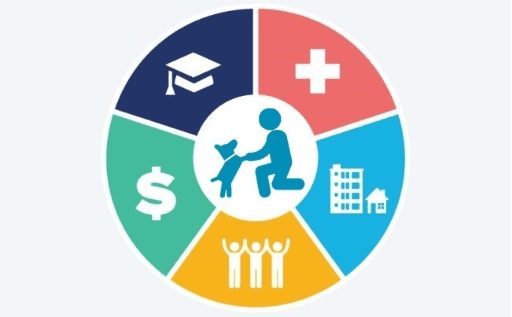Social Determinants of Health
Environmental pollutants and climate change are two factors closely tied to human and animal health. By knowing how Social Determinants of Health and Climate Change are affecting us, we can take the necessary steps to provide better environments for our homes and businesses.
Social Determinants of Health (SDoH) refer to the non-medical factors impacting overall health. These factors are at the center of a host of policies and initiatives by government agencies, health systems, and even the commercial sector. Noise pollution, poor air quality, and poor water quality are three environmental factors known to have a strong link to one’s health and well-being. Ultimately, addressing SDoH is about employing new sources of data and technologies to look beyond traditional care models in support of a complete health strategy.
For the Health People 2030 Project, the US Department of Health and Human Services (HSS) has included the following as one of four overarching goals for the decade: “Create social, physical, and economic environments that promote attaining the full potential for health and well-being for all.
This particular goal highlights the importance of addressing SDoH, an emphasis shared by the World Health Organization (WHO) Commission on Social Determinants of Health and published in the WHO guidelines for the intersection of Social Determinants of Health, Housing, Healthcare and Public Health. The growing list of SDoH-related programs is diverse in approach and size. But what has become consistent is the understanding by healthcare leadership that, in order to deliver better health outcomes, social determinants must be addressed. Moreover, the relationship between healthcare outcomes and SDoH factors such as noise pollution, air quality and water quality must be definitively determined.
Climate Change
While debate continues to surround the details of climate change, there is medical and scientific consensus that these changes clearly are occurring and also progressing. Wind speeds are increasing, the number of solar days is decreasing, and global temperatures are rising. And these environmental shifts are affecting not only flora and fauna but also the health of people on every continent.
Unprecedented fires in the western United States, Australia and the Amazon rainforest, as well as record rainfall across Europe and the North American coasts, are yet more proof that the Earth’s climate is shifting. The WHO and the US Centers for Disease Control (CDC) have identified environmental heat exposure as an evolving threat in homes and in the workplace.
Shifting global temperatures have been demonstrated not only to increase stress levels but also to increase the rates of aggression, bullying, verbal abuse and even workplace violence. Studies in several urban areas found that for every 2 degree rise in average yearly temperature, the rates of homicides, assaults and suicides rose by 3%. Interestingly, these increases were mitigated by indoor environmental temperature and humidity control. But as global temperatures rise, so too does the cost of cooling indoor spaces. Home and business owners can save up to 30% on their heating and cooling costs while reducing their carbon footprint, though, by installing a SMART ventilation controller. This type of controller uses outdoor air to heat or cool the indoor space, as opposed to engaging the condenser, when outdoor temperature and humidity are appropriate for the task.
Environmental Pollutants
As outdoor temperatures swing through increasing extremes of temperature and higher allergen production, many people will spend more and more time indoors. Living or working in confined quarters increases exposure to illness and contributes to poor indoor air quality. Finding ways to reduce that risk and monitor your efforts is key. The COVID-19 pandemic punctuated the impact of indoor and outdoor pollutants on immunity, health and disease.
Indoor Air Quality (IAQ) is vital because contaminants such as radon, volatile organic compounds (VOCs), and other pollutants can build up indoors, leading to potentially serious health problems. Poor air quality increases blood pressure, risk of fatal heart attack, and stroke by increasing the body’s stress response (also known as “Fight or Flight” response). By simply using a SMART ventilation controller to optimize air quality, you can reduce your family’s stress level or the stress level of your employees by up to 14%. This is a year-round need and is especially important during the extreme temperature months of the summer and winter, when many of us spend more time indoors.
High Alert Institute
4800 Ben Hill Trail
Lake Wales, FL 33898
Office: 863.696.8090
FAX: 407.434.0804
Info@HighAlertInstitute.org
Privacy Policy
Cookie Policy
Terms of Use
Disclaimers
Get Your Data
Shipping Policy
Message Us
Transparency
Registrations
Do Not Sell Info
Return Policy
A COPY OF THE OFFICIAL REGISTRATION AND FINANCIAL INFORMATION MAY BE OBTAINED FROM THE DIVISION OF CONSUMER SERVICES BY CALLING TOLL-FREE, WITHIN THE STATE, 1-800-435-7352 (800-HELP-FLA), OR VISITING www.FloridaConsumerHelp.com. REGISTRATION DOES NOT IMPLY ENDORSEMENT, APPROVAL, OR RECOMMENDATION BY THE STATE. Florida Registration #CH68959
REGISTRATION WITH A STATE AGENCY DOES NOT CONSTITUTE OR IMPLY ENDORSEMENT, APPROVAL OR RECOMMENDATION BY THAT STATE.













